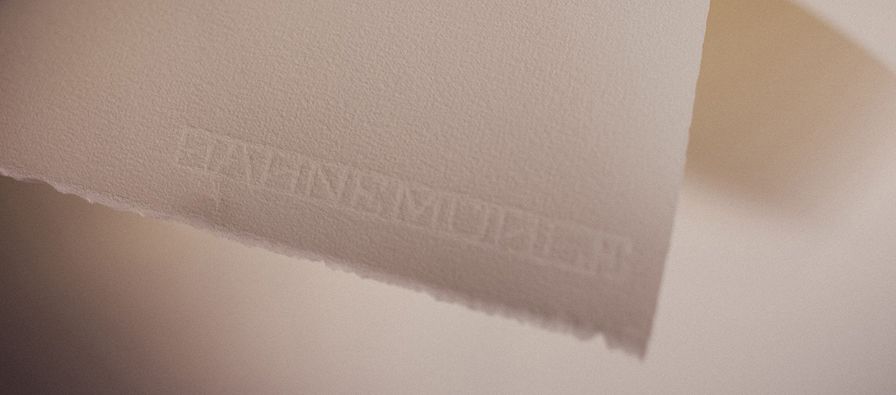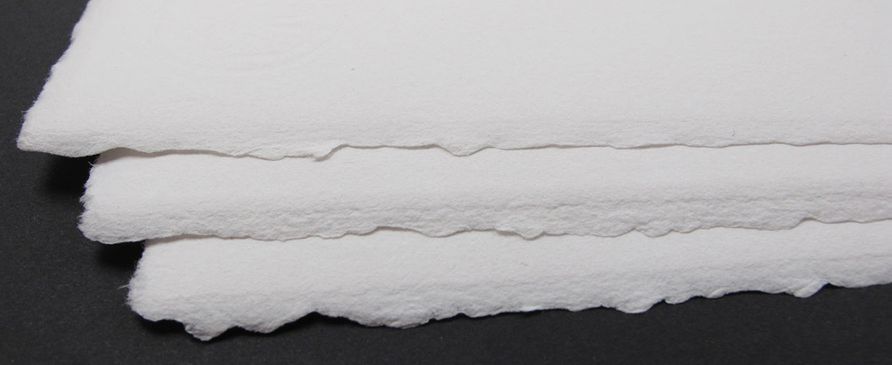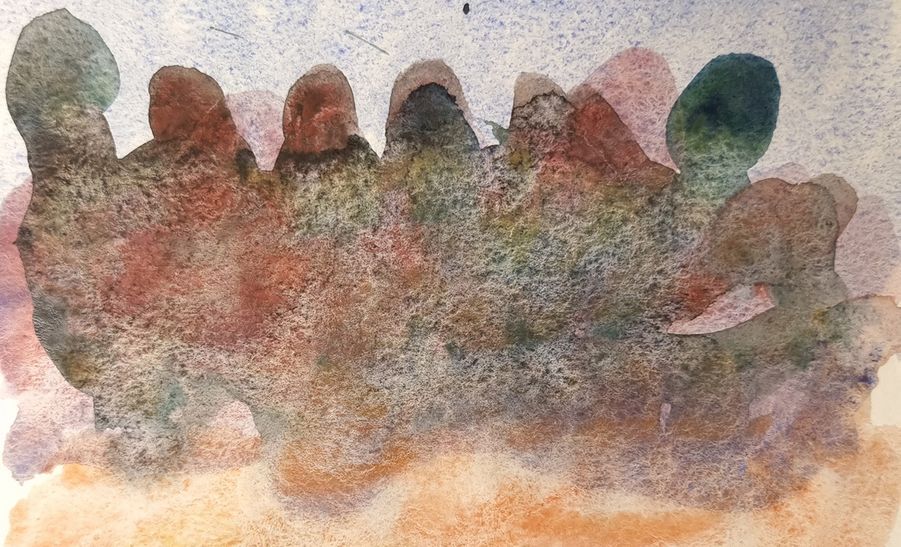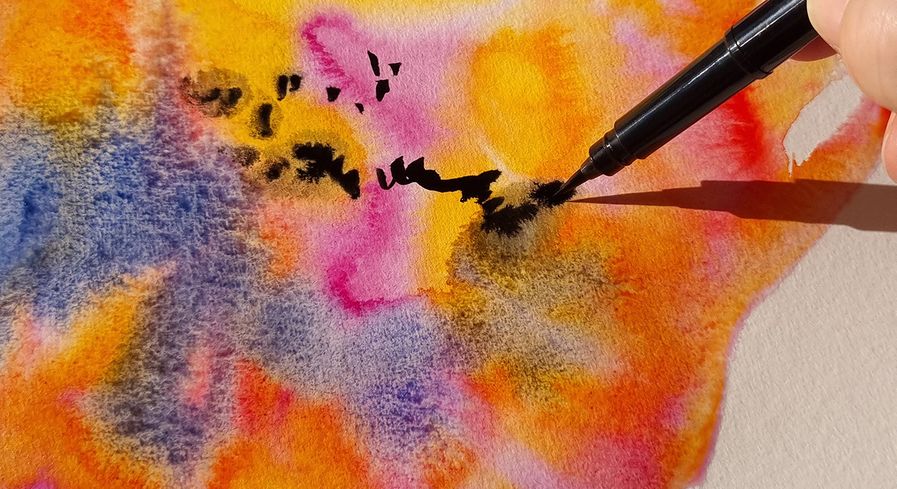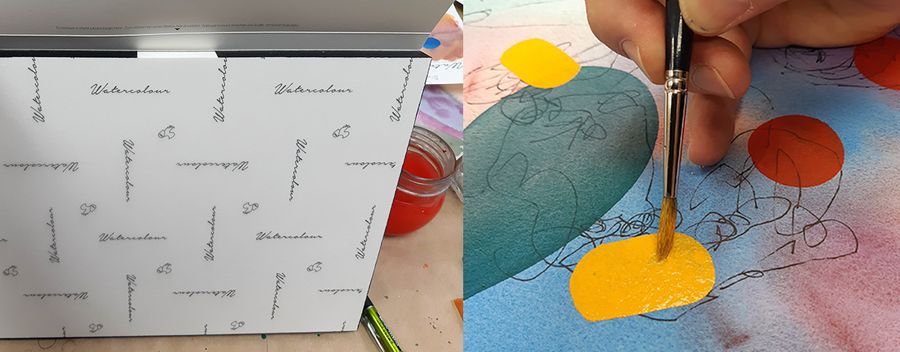Shop Now
-
ACRYLIC PAINTS & MEDIUMS
- Specials
- New Arrivals
- Featured
- Clearance
- ART SPECTRUM ACRYLIC MEDIUMS
- ART SPECTRUM COLOURFIX PRIMER
- ATELIER MEDIUMS
- AUREUO ACRYLIC PAINT SETS
- CHROMACRYL MEDIUMS
- CHROMACRYL STUDENT ACRYLIC
- DERIVAN MEDIUMS
- DERIVAN STUDENT ACRYLIC PAINT
- EXPRESSION PAINTING SETS
- FLASHE
- FLUID WRITER PENS
- GOLDEN FLUID ACRYLIC
- GOLDEN HEAVY BODY ACRYLIC
- GOLDEN HIGH FLOW ACRYLIC
- GOLDEN MEDIUMS & VARNISHES
- GOLDEN OPEN ACRYLIC
- GOLDEN SOFLAT MATTE ACRYLIC
- MATISSE BACKGROUND
- MATISSE MEDIUMS
- MATISSE STRUCTURE
- NAM VARNISHES
- PEBEO ACRYLIC MEDIUMS
- PEBEO ORIGIN ACRYLIC
- PEBEO STUDIO ACRYLIC
- SCHMINCKE ACRYLIC MEDIUMS
- SCHMINCKE AEROCOLOR ACRYLIC
- SCHMINCKE AKADEMIE ACRYLIC
- WINSOR & NEWTON ACRYLIC MEDIUMS
- WINSOR & NEWTON ARTISTS ACRYLIC
- AIRBRUSHES
- ART ACCESSORIES
- ART BAGS, PORTFOLIOS & PRESENTATION
- BOARD & CARD
-
BOOKS
- New Arrivals
- BOOKS ACRYLIC PAINTING
- BOOKS ARCHITECTURE
- BOOKS ART AND CRAFT KITS
- BOOKS CHARACTER DESIGN
- BOOKS COLOUR THEORY
- BOOKS COLOURING BOOKS
- BOOKS CREATIVE KIDS
- BOOKS DRAWING
- BOOKS FASHION & TEXTILES
- BOOKS FIGURE DRAWING
- BOOKS FLORA AND FAUNA
- BOOKS GRAPHIC DESIGN
- BOOKS HAND LETTERING
- BOOKS ILLUSTRATION
- BOOKS KAWAII
- BOOKS LOGO DESIGN
- BOOKS MANGA
- BOOKS MIXED MEDIA
- BOOKS MONOGRAPHS
- BOOKS MOTIVATIONAL
- BOOKS NZ AOTEAROA ART
- BOOKS OIL PAINTING
- BOOKS ORIGAMI
- BOOKS PACKAGING DESIGN
- BOOKS PAPER ARTS
- BOOKS PHOTO TECHNIQUES
- BOOKS PHOTOGRAPHY
- BOOKS PRINTMAKING
- BOOKS PRODUCT DESIGN
- BOOKS PUZZLES AND GAMES
- BOOKS SCULPTURE AND CLAY
- BOOKS STREET ART
- BOOKS TYPOGRAPHY
- BOOKS URBAN SKETCHING
- BOOKS WATERCOLOUR PAINTING
-
BRUSHES & PALETTE KNIVES
- Specials
- New Arrivals
- Featured
- Clearance
- BAMBOO BRUSHES
- BRUSH SOAP & CLEANERS
- BRUSH STANDS & STORAGE
- COLOUR SHAPERS
- DA VINCI BLACK SABLE BRUSHES
- DA VINCI BRISTLE BRUSHES
- DA VINCI BRUSH SETS
-
DA VINCI CASANEO WATERCOLOUR BRUSH
- DA VINCI CASANEO FLAT BRUSH
- DA VINCI CASANEO LINER BRUSH
- DA VINCI CASANEO MINI BRUSHES
- DA VINCI CASANEO MOTTLER
- DA VINCI CASANEO OVAL BRUSH
- DA VINCI CASANEO POCKET TRAVEL BRUSH
- DA VINCI CASANEO RIGGER BRUSH
- DA VINCI CASANEO ROUND BRUSH
- DA VINCI CASANEO SHORT STROKE BRUSH
- DA VINCI CASANEO SLANT EDGE BRUSH
- DA VINCI CASANEO WASH BRUSH
- DA VINCI CHUNEO SYNTHETIC BRISTLE BRUSHES
- DA VINCI COLINEO OIL & ACRYLIC LONG HANDLED BRUSHES
-
DA VINCI COLINEO WATERCOLOUR BRUSHES
- DA VINCI COLINEO WATERCOLOUR BRUSH FAN
- DA VINCI COLINEO WATERCOLOUR BRUSH FLAT
- DA VINCI COLINEO WATERCOLOUR BRUSH RETOUCHING
- DA VINCI COLINEO WATERCOLOUR BRUSH RIGGER
- DA VINCI COLINEO WATERCOLOUR BRUSH ROUND
- DA VINCI COLINEO WATERCOLOUR BRUSH SLANTED
- DA VINCI COLINEO WATERCOLOUR BRUSH WASH
- DA VINCI COLINEO WATERCOLOUR BRUSH X POINT
- DA VINCI COSMOTOP MIX BRUSHES
- DA VINCI COSMOTOP NOVA BRUSHES
- DA VINCI COSMOTOP SPIN BRUSHES
- DA VINCI COSMOTOP WASH BRUSHES
- DA VINCI DRY BRUSHES SYNTHETIC
- DA VINCI FORTE BRUSHES
- DA VINCI IMPASTO BRUSHES
- DA VINCI JUNIOR SYNTHETIC BRUSHES
- DA VINCI KOLINSKY RED SABLE BRUSHES
- DA VINCI LETTERING BRUSHES
- DA VINCI MAESTRO2 BRISTLE BRUSHES
- DA VINCI MICRO BRUSHES
- DA VINCI SPECIAL BRUSHES
- DA VINCI SQUIRREL/WASH BRUSHES
-
DA VINCI STUDENT BRUSHES
- DA VINCI COLLEGE BRUSH FILBERT
- DA VINCI COLLEGE BRUSH FLAT
- DA VINCI COLLEGE BRUSH ROUND
- DA VINCI FIT HOBBY BRUSH FILBERT
- DA VINCI FIT HOBBY BRUSH FLAT
- DA VINCI FIT HOBBY BRUSH ROUND
- DA VINCI FIT HOBBY SYNTHETIC MOTTLER BRUSH
- DA VINCI FIT SYNTHETIC BRISTLE BRUSH FLAT
- DA VINCI FIT SYNTHETIC BRISTLE BRUSH ROUND
- DA VINCI STUDENT BRISTLE ROUND
- DA VINCI TOP-ACRYL BRUSHES
- ESSDEE SPONGE ROLLERS
- EXPRESSION BRUSHES
- JASART 577 ETERNA BRUSH
- JASART HOG BRISTLE BRUSHES
- JASART MOP & STENCIL BRUSHES
- PALETTE KNIVES
- PEBEO BRUSH SETS
- PEBEO IRIS BRUSHES
- PEBEO MOTTLER BRUSHES
- WINSOR & NEWTON COTMAN WATERCOLOUR BRUSHES
- WINSOR & NEWTON GALERIA BRUSHES
- WINSOR & NEWTON SCEPTRE GOLD BRUSHES
- WINSOR & NEWTON SERIES 7 BRUSHES
- WINSOR & NEWTON WINTON BRUSHES
-
CANVAS & PANELS
- Specials
- CANVAS ROLLS
- CANVAS STRETCHING TOOLS
- CEDAR STRETCHER BARS
- EXPRESSION CANVAS PANELS
- EXPRESSION FLOATING CANVAS FRAMED
- EXPRESSION STRETCHED CANVAS
- FREDRIX STRETCHED CANVAS, PANELS, PADS
- MUSEO LINEN CANVAS
- MUSEUM STRETCHED CANVAS
- NAM NATURAL LINEN CANVAS
- NAM ROUND CANVAS PANELS
- PINE STRETCHER BARS & BRACES
- PRO-PANELS
- SKATEBOARD DECK ART BOARD
- STRETCHED WITH LOVE CANVAS
- CERAMIC PAINT
- DRAWING BOARDS,STANDS & TABLES
- EASELS
- ENCAUSTIC PAINTS & MEDIUMS
- ENVELOPES
- FABRIC PAINT & DYES
- FACE & BODY PAINT
- FOAMBOARD
- GIFT CARDS
- GLASS PAINT
- GOUACHE PAINTS
- INKS
-
KNIVES & CUTTING TOOLS
- Specials
- New Arrivals
- Featured
- Clearance
- DAFA CUTTING TOOLS
- DAFA RULERS
- DESIGN PEN KNIFE
- EXCEL KNIVES & CARVING TOOLS
- EXPRESSION CUTTING MATS
- FISKARS CUTTING TOOLS
- LEDAH TRIMMERS & GUILLOTINES
- LOGAN CUTTING & FRAMING TOOLS
- REVOLVING LEATHER PUNCH
- SCISSORS
- SNAP BLADE KNIVES & BLADES
- SWANN MORTON SCALPEL KNIVES & BLADES
- LIGHT PADS, LIGHTBOXES & LIGHTING
-
MARKERS & PENS
- Specials
- New Arrivals
- Featured
- Clearance
- ARTLINE PENS
- AUREUO ALCOHOL TWIN TIP MARKER SETS
- CALLIGRAPHY PENS & NIBS
- CLASS PACKS MARKERS & PENS
- COPIC CIAO MARKERS
- COPIC CLASSIC MARKERS
- COPIC GASENFUDE BRUSH PENS
- COPIC MULTI LINERS
- COPIC REFILL INKS
- COPIC SKETCH MARKERS
- CORRECTION TAPES & PENS
- FABER CASTELL ALBRECHT DURER WATERCOLOUR MARKERS
- FABER CASTELL CONNECTOR PEN SETS
- FABER CASTELL GRIP PLUS BALL PENS
- FABER CASTELL PITT ARTIST DUAL MARKER
- FABER CASTELL PITT ARTIST PENS
- ICON PENS & MARKERS
- INDIGRAPH FOUNTAIN PENS
- LAMY PENS
- MARKER WALLETS & STORAGE
- MOLOTOW BLACKLINER PIGMENT LINER PENS
- MOLOTOW BURNER MARKERS
- MOLOTOW CHALK MARKERS - REFILLABLE
- MOLOTOW DRIPSTICKS
- MOLOTOW EXCHANGE TIPS
- MOLOTOW GRAFX MASKING LIQUID
- MOLOTOW LIQUID CHROME MARKERS
- MOLOTOW MASTERPIECE PAINT MARKERS
- MOLOTOW ONE4ALL PAINT MARKERS
- MOLOTOW SKETCHER MARKERS
- PEBEO 4ARTIST OIL BASED PAINT MARKERS
- PEBEO COLOREX WATERCOLOUR INK MARKERS
- PENTEL PENS
- PILOT MR SERIES PENS
- PILOT PENS
- POSCA MARKERS
- ROTRING PENS
- SCHMINCKE AERO LINER EMPTY MARKERS
- SCHNEIDER
- SHARPIE
- SHARPIE CREATIVE MARKER SETS
- STABILO FINELINER PENS
- STAEDTLER COLOUR FIBRE TIP PEN
- STAEDTLER DESIGN JOURNEY MARKER SETS
- STAEDTLER LUMOCOLOR MARKERS
- STAEDTLER MARS MATIC TECH PENS
- STAEDTLER PIGMENT ARTS PEN
- STAEDTLER PIGMENT LINER
- STAEDTLER TEXTSURFER HIGHLIGHTERS
- STAEDTLER TRIPLUS FINELINERS
- STAEDTLER WRITING PENS
- TEXTA LIQUID CHALK MARKERS
- TOMBOW DUAL BRUSH PENS
- TOMBOW FUDENOSUKE PENS
- U-KNOCK XQ GEL PEN
- UNI PENS & MARKERS
- WINSOR & NEWTON BRUSH MARKERS
- WINSOR & NEWTON PROMARKERS
- ZIG PENS
-
MODELLING , SCULPTING, CLAY & RESIN
- Specials
- New Arrivals
- Featured
- Clearance
- 3D PRINTING FILAMENT
- BALSA & BASSWOOD
- CHAVANT MODELLING CLAY
- CLAY SHAPERS
- CLAYTOON NON-HARDENING MODELLING CLAY
- DAS MODELLING CLAY
- ESSDEE ALUMINIUM ROLLERS
- EXCEL MODELLING TOOLS
- EXPRESSION MODELLING TOOLS
- FIMO
- FIMO AIR-DRY MODELLING CLAY
- FIMO EFFECT
- FIMO KIDS
- FIMO LEATHER-EFFECT
- FIMO PROFESSIONAL
- FIMO TOOLS & ACCESSORIES
- GEDEO CLAY, RESIN & MOULDING
- HOT WIRE FOAM TOOLS
- JOVI AIR HARDENING CLAY
- K&S METALS
- KIWI UNDERGLAZE
- MACS MUD CLAYS
- MDF BOARD & PLYWOOD PANELS
- MILLIPUT EPOXY PUTTY
- MISCELLANEOUS MODELLING TOOLS
- MODELLING COMPOUNDS & PLASTER
- MODELLING WIRE
- NORSKI RESINS & ACCESSORIES
- PEBEO FLUID PIGMENTS FOR RESINS
- PLASTALINA NON-HARDENING MODELLING CLAY
- PLASTIC SHEET PRODUCTS
- POP STICKS
- PROTOLINA NON-HARDENING MODELLING CLAY
- RGM SCULPTING TOOLS
- SCULPEY CLAYS
- SCULPEY LIQUID BAKEABLE CLAY
- SCULPEY PREMO CLAY
- SCULPEY SOUFFLE CLAY
- SCULPEY TOOLS & ACCESSORIES
- WOODEN SHEETS & STICKS
-
OIL PAINTS & MEDIUMS
- Specials
- New Arrivals
- Clearance
- ART SPECTRUM ARTIST OILS
- ART SPECTRUM OIL MEDIUMS
- CHROMA ARCHIVAL OIL MEDIUMS
- EXPRESSION WATERSOLUBLE OIL STICKS
- FIVE STAR OIL MEDIUMS
- GAMBLIN MEDIUMS
- MAIMERI CLASSICO OIL
- MICHAEL HARDING OILS
- OLD HOLLAND OIL COLOURS
- PEBEO OIL MEDIUMS
- PEBEO XL OIL
- R&F PIGMENT OIL PAINT STICKS
- SCHMINCKE ARTIST OIL FLAKE WHITE
- SCHMINCKE MUSSINI OIL
- SCHMINCKE NORMA BLUE WATER-MIXABLE OIL
- SCHMINCKE NORMA PROFESSIONAL OIL
- SCHMINCKE OIL MEDIUMS
- SHELLAC
- TMK SOLVENTS & SPIRITS
- WILLIAMSBURG OIL
- WINSOR & NEWTON ARTISAN WATER MIXABLE OILS
- WINSOR & NEWTON ARTISTS OILS
- WINSOR & NEWTON GRIFFIN ALKYD FAST DRYING OIL COLOUR
- WINSOR & NEWTON OIL MEDIUMS
- WINSOR & NEWTON WINTON OILS
- PACKAGING PRODUCTS
-
PADS, BLOCKS & PACKS
- Specials
- New Arrivals
- Clearance
- ARCHES PADS & BLOCKS
- AWAGAMI WASHI PACKS
- BOCKINGFORD PADS
- CANSON PADS & BLOCKS
- CLAIREFONTAINE PASTELMAT PADS
- COLOURFIX PADS & PACKS
- FABRIANO PADS, PACKS & BLOCKS
- GORDON HARRIS PADS
- GRAPH PAPER PADS & SHEETS
- HAHNEMUHLE PADS, PACKS AND BLOCKS
- LANA FINE ART PAPER PADS
- MAGNANI BLOCKS & PADS
- MOLOTOW MARKER PADS
- WARWICK EXERCISE BOOKS & PADS
- WINSOR & NEWTON MARKER PADS
- X-PRESS IT BLENDING PADS
- PANTONE GUIDES
- PAPER & CARD COLOURED
- PAPER ACCESSORIES
-
PAPER FINE ART
- Specials
- New Arrivals
- Clearance
- ARCHES FINE ART PAPERS
- AWAGAMI FINE ART PAPERS
- CANSON MI-TEINTES PAPER
- CANSON WATERCOLOUR PAPERS
- CARTRIDGE PAPER
- COLOURFIX PAPER
- EXPRESSION RENDERING PAPER
- FABRIANO FINE ART PAPERS
- GLASSINE PAPER
- HAHNEMUHLE FINE ART PAPER - ROLLS
- HAHNEMUHLE FINE ART PAPER - SHEETS
- KHADI PRINTMAKING PAPER
- LANA FINE ART PAPERS
- MAGNANI FINE ART PAPERS
- NEWSPRINT PAPER
- SCHOOL ART PAPER & CARD
- YUPO SYNTHETIC PAPER
-
PASTELS & PASTEL PENCILS
- Specials
- New Arrivals
- Featured
- Clearance
- CARAN D'ACHE NEOPASTEL
- CRETACOLOR PASTEL STICKS
- DERWENT PASTEL PENCIL SETS
- FABER CASTELL PITT PASTEL PENCILS
- FABER CASTELL POLYCHROMOS PASTELS
- HARD & SOFT PASTELS
- MUNGYO OIL PASTELS
- MUNGYO SEMI-HARD PASTELS
- MUNGYO SOFT PASTELS
- NAM VARNISHES
- OIL PASTELS
- PAN PASTELS
- PASTEL FIXATIVES & GROUNDS
- SCHMINCKE PASTELS
- STAEDTLER DESIGN JOURNEY PASTEL & CRAYON SETS
-
PENCILS, CRAYONS, CHARCOAL & ACCESSORIES
- Specials
- New Arrivals
- Featured
- Clearance
- ART GRAF GRAPHITE & CARBON
- BLACKWING
- CARAN D'ACHE LUMINANCE SETS
- CARAN D'ACHE NEOCOLOR I
- CARAN D'ACHE PABLO
- CARAN D'ACHE SUPRACOLOUR
- CHALK & ACCESSORIES
- CLASS PACKS PENCILS
- CLUTCH PENCILS, LEAD HOLDERS & LEADS
- COATES WILLOW CHARCOAL
- CONTE CRAYONS
- CRETACOLOR ARTISTS' COLOUR PENCILS
- CRETACOLOR CHARCOAL & GRAPHITE
- CRETACOLOR DRAWING & COLOUR PENCIL SETS
- Caran D'Ache NEOCOLOR CRAYONS
- DERWENT INKTENSE SINGLE PENCIL
- DERWENT SETS
- DONGXU WILLOW CHARCOAL STICKS
- DRAWING ACCESSORIES
- ERASERS
- EXPRESSION PAPER STUMPS
- FABER CASTELL 9000 PENCILS
- FABER CASTELL ALBRECHT DURER WATERCOLOUR PENCILS
- FABER CASTELL ARTISTS PENCILS
- FABER CASTELL GOLDFABER 1221 PENCILS
- FABER CASTELL PITT CHARCOAL & GRAPHITE
- FABER CASTELL PITT PASTEL STICKS
- FABER CASTELL POLYCHROMOS ARTISTS COLOUR PENCILS
- FABER CASTELL RED RANGE CLASSIC PENCIL SETS
- FABER CASTELL UNIVERSAL MARKING PENCILS
- GENERALS CHARCOAL PENCILS
- HONEYSTICKS BEESWAX CRAYONS
- ICON PENCILS
- JOLLY X-BIG SUPERSTICK PENCILS
- LAMY COLOUR PENCIL SETS
- MECHANICAL PENCILS
- MOLESKINE PENCILS
- MUNGYO WATERCOLOUR CRAYONS
- PENCIL CASES & WRAPS
- PRISMACOLOR PENCILS
- SHARPENERS
- STAEDTLER COLOUR PENCIL SETS
- STAEDTLER CRAYON & PASTEL SETS
- STAEDTLER DESIGN JOURNEY COLOUR PENCIL SETS
- STAEDTLER LUMOCOLOR PENCILS
- STAEDTLER LUNA PENCILS
- STAEDTLER MARS LEADS
- STAEDTLER MARS LUMOGRAPH PENCILS
- STAEDTLER NORIS,NORICA PENCILS
- STAEDTLER TRADITION PENCILS
- TOMBOW MONO GRAPHITE PENCILS
- WOLFF CARBON PENCILS
- PIGMENTS & MEDIUMS
- PRINTER PAPERS, FILMS & LABELS
-
PRINTMAKING
- Specials
- New Arrivals
- Clearance
- BLOCK PRINTING KITS
- CHARBONNEL ETCHING GROUNDS
- ESSDEE SCRAPERBOARD
- GELLI PRINTING PLATES
- JACQUARD CYANOTYPE
- JACQUARD SOLARFAST
- PRINTING PLATES, BLOCKS & LINO
- PRINTING PRESSES
-
PRINTMAKING INKS
- AKUA INTAGLIO INK
- AKUA INTAGLIO MEDIUMS
- CHARBONNEL ETCHING INKS
- CHARBONNEL WATER WASHABLE INK
- CHARBONNEL WATER WASHABLE MEDIUMS
- CRANFIELD CALIGO SAFE WASH ETCHING INKS
- CRANFIELD CALIGO SAFE WASH RELIEF INK
- CRANFIELD PRINTMAKING MEDIUMS
- CRANFIELD TRADITIONAL ETCHING INKS
- CRANFIELD TRADITIONAL RELIEF INKS
- ESSDEE FABRIC PRINTING INKS
- ESSDEE WATERBASED BLOCK PRINTING INKS
- FIVE STAR PRINTING INK
- FLINT OIL BASED PRINTING INK
- FLINT WATER BASED PRINTING INK
- SCHMINCKE AQUA LINOPRINT INKS
- SCHMINCKE LINOPRINT MEDIUMS
- SCHMINCKE LINOPRINT SETS
- SPEEDBALL FABRIC RELIEF INKS
- SPEEDBALL PROFESSIONAL RELIEF INKS
- SPEEDBALL WATERBASED RELIEF INKS
-
PRINTMAKING ROLLERS, CUTTERS & TOOLS
- BARENS
- BENCH HOOKS
- ESSDEE COLD WAX ROLLERS
- ESSDEE FABRIC INK ROLLERS
- ESSDEE HARD RUBBER INK ROLLERS
- ESSDEE PROFESSIONAL INK ROLLERS
- ESSDEE SOFT RUBBER INK ROLLERS
- ETCHING NEEDLES
- EXPRESSION STANDARD RUBBER INK ROLLERS
- HWAHONG ROLLERS & TOOLS
- LINO & WOOD CUTTERS & CARVING TOOLS
- SPEEDBALL LINO ROLLERS
- PRINTMAKING STENCILS
- PROJECTORS
- SCHOOL & UNIVERSITY KITS
- SCREENPRINTING
-
SKETCH BOOKS, NOTEBOOKS, VISUAL DIARIES
- Specials
- New Arrivals
- Clearance
- CRESCENT RENDR SKETCHBOOKS
- FABRIANO ECOQUA NOTEBOOKS
- FABRIANO ISPIRA NOTEBOOKS
- FABRIANO SKETCH & WATERCOLOUR BOOKS
- FLEXBOOK SKETCHBOOKS & NOTEBOOKS
- GORDON HARRIS VISUAL DIARIES
-
HAHNEMUHLE SKETCH BOOKS
- HAHNEMUHLE CAPPUCINO BOOK
- HAHNEMUHLE NOSTALGIE SKETCH BOOK
- HAHNEMUHLE SKETCH BOOK D&S
- HAHNEMUHLE SKETCH BOOK HARDCOVER
- HAHNEMUHLE SKETCH BOOKLETS
- HAHNEMUHLE SPIRAL BOUND SKETCH BOOKS
- HAHNEMUHLE THE GREY BOOK
- HAHNEMUHLE TONED WATERCOLOUR BOOKS
- HAHNEMUHLE TRAVEL JOURNALS
- HAHNEMUHLE WATERCOLOUR BOOKS
- HAHNEMUHLE ZIG ZAG BOOK
- LEUCHTTURM 1917 NOTEBOOKS
- MOLESKINE NOTEBOOKS
- MOLOTOW MARKER SKETCHBOOK
- PAPERBLANKS NOTEBOOKS
- SPECIALTY PAINTS & FINISHES
- SPRAY PAINT
- STATIONERY
-
TAPES, GLUES & ADHESIVES
- Specials
- Clearance
- ADHESIVE PUTTIES & CEMENTS
- ARTOGRAPH SPRAY BOOTHS
- CELLULOSE & INVISIBLE TAPES
- DOUBLE SIDED TAPES & SHEETS
- GLUE GUNS & STICKS
- GLUE STICKS & ROLLERS
- HOLDFAST HOOK & LOOP
- MASKING TAPES & FILMS
- PACKAGING TAPE
- PAPER & CLOTH TAPES
- PVA & WOOD GLUES
- SELF ADHESIVE SHEETS & ROLLS
- SPECIALITY & ALL PURPOSE GLUES
- SPRAY ADHESIVES
- XYRON PROFESSIONAL
- TECHNICAL DRAWING PRODUCTS
- TRACING PAPER & DRAFTING FILM
-
WATERCOLOUR PAINTS & MEDIUMS
- Specials
- New Arrivals
- Clearance
- DANIEL SMITH WATERCOLOUR
- PEBEO WATERCOLOUR MEDIUMS
- PEBEO WATERCOLOUR PAINT SETS
- QOR WATERCOLOURS
- SCHMINCKE AKADEMIE WATERCOLOUR
- SCHMINCKE AQUA DROP
- SCHMINCKE HORADAM WATERCOLOUR
- SCHMINCKE LIQUID CHARCOAL
- SCHMINCKE WATERCOLOUR MEDIUMS
- WATERBRUSH PENS
- WATERCOLOUR STUDENT PAINT SETS
- WINSOR & NEWTON COTMAN WATERCOLOURS
- WINSOR & NEWTON PROFESSIONAL WATERCOLOUR
- WINSOR & NEWTON WATERCOLOUR MARKERS
- WINSOR & NEWTON WATERCOLOUR MEDIUMS
Hahnemühle Fine Art Papers for painting, drawing, and printmaking.
In 1584, the Hahnemühle paper mill was founded in Lower Saxony, Germany, at a special freshwater spring that provides the all-important water for their high-quality papers.
The oldest paper manufacturer in Germany, Hahnemühle still produces traditional artist papers at the same location, based on traditional recipes using the finest fibres and pure spring water. Their paper technologists are also constantly refining the processes when it comes to new applications in artist trends around the world. Their motto always has been ‘Quality instead of Quantity’.
Artist papers differ according to the raw materials and the production method. At Hahnemühle, a distinction is made between genuine mould-made papers, produced on the cylinder mould paper machine, and Akademie papers, which are made on the fourdrinier paper machine.
Mould-made Paper

Hahnemühle is one of only a few paper manufacturers worldwide still producing real mould-made papers using the traditional cylinder mould method. By using different mould structures, Hahnemühle can produce various paper surfaces and sizes with the four deckled edges characteristic of hand-made paper.
First, a highly diluted mixture of first-class cellulose pulp or cotton fibres and pure spring water is added to the vat. The fibres then deposit themselves unstructured on the cylinder mould and form a fibrous web. The water flows through the cylinder mould back into the vat. At the crown of the cylinder, the paper mat is moved onto a felt to be transported into the machine.
Watermarks and metal studs for limiting the paper format are stitched with copper wire onto the perforated cylinder by hand. Only a few paper fibres deposit themselves on this part of the paper mash. The still moist paper can be “torn” at the predetermined thinner line. Only paper edges made this way may be called a real deckle edge.
A sure sign of the highest quality – genuine deckle edged papers made on a cylinder machine.
Real wool felts transport the paper within the papermaking machine and while doing that, mark the paper with a unique surface and create the handcrafted feel of real artist paper. At only 4 – 15 m/min the machine speed is comparatively low, but absolutely necessary due to the highest quality requirements for genuine artist paper. The large weight per unit area ranges from 80 up to 640 gsm, allowing a broad range of different mould-made paper grades for Hahnemühle´s Traditional Fine Art Papers.
Hahnemühle Mould-made Papers include:
The Collection, William Turner, Leonardo, 1584 printmaking paper, Etching paper, 300gsm Watercolour.
Fourdrinier Papers
Papers made on the fourdrinier paper machine offer a professional surface to work on at a more affordable price. In this machine, all the fibres are deposited in the machine’s running direction, giving the paper its grain direction and making the flow behaviour of watercolour paints easy to predict and influence.
The heart of the fourdrinier paper machine is a continuously rotating, flat plastic mould. The mixture of spring water and paper fibres flows evenly onto it. The water runs off through the mould, while the paper fibres are deposited in the machine’s running direction and bond to the paper on the mould. Felts then further transports this web of fibres through the machine, where it runs over steam-heated cylinders between two felts. The paper web is dried and pressed. Hahnemühle felts, which are made
of wool or mixed fabrics comprising synthetic fibres and wool, mark the paper’s surface with their characteristic texture. This is consistent, so that you’re always getting your favourite paper with the same texture.

It's important to note that at Hahnemühle, the papers are felt-marked during the production process. Always look out for this feature of real artist papers as it guarantees the handcrafted character. Cheaper watercolour papers are often embossed once production is complete, and are inferior in appearance and performance.
All papers from the fourdrinier paper machine are gently dried and smoothed, continuously checked and then wound. The paper machine runs at a speed of up to 105 m/min, enabling high quality artist papers to be produced at a very affordable price.
Papers produced on the Fourdrinier machine include:
Natural Line, Harmony, Britannia, Andalusia.
Cotton/Rags
All Hahnemühle cotton papers are marked with a small logo symbolising a cotton plant. The Terms ‘100% rags’ or ‘100% Cotton’ also appear on the label. The word ‘rags’ is the old term for the textile fibres that paper used to be made from, before pulp (wood fibres) was discovered as a raw material for paper in 1843. Consequently, it was usual to grind old textiles into fibres – which were known as ‘rags’. Nowadays, however, linters have replaced rags. Linters are short, valuable fibres of cotton seeds. Hahnemühle processes these fibres, which are by-products of the textile and oil industry. No extra cotton is planted for their papers.
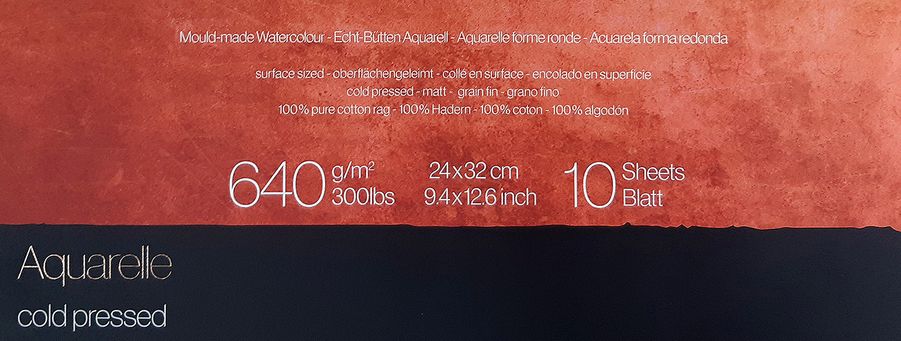
Cotton gives paper its wet-strength (note that so called “wet strength cartridge” has no cotton content), as its fibres lock to form a durable construction; during application of wet colours the paper does not move as much as a wood-free pulp paper. Cotton is expensive, so used only for the highest quality papers.
Pulp
Pulp used for Hahnemühle artist papers is high-purity alpha-cellulose. The fibres come from deciduous and coniferous species of trees. All raw materials come from certified and sustainable sources and are gently bleached. Bleaching is necessary so that the wood pigment, lignin, does not cause the paper to yellow. These raw materials carry the Forest Stewardship Council (FSC) seal, the TCF seal or the ECF seal for chlorine-free bleaching, which works without environmentally harmful chlorine compounds.
Hahnemühle papers made from pulp are as archival as cotton papers, but don’t possess the same wet strength.
Water
Since the paper mill was established in 1584, Hahnemühle has been using pure spring water from the Solling mountains to produce their high-quality papers. More than four centuries ago, the availability of water was the most important factor in Hahnemühle choosing to settle there and, because the papers require the pure, soft spring water, they still produce at this very same location. This spring water from artesian wells always has a consistent quality, so unlike river water, it doesn’t have to be chemically treated. Most of the water is collected in the production cycle and reused. Their wastewater is not contaminated with pollutants and is returned to the water cycle.
Sizing
Size is an additive that controls the absorption of paint into a paper. There are two types of sizing: material (or internal) sizing, and surface sizing. During material sizing, the size enters the paper as an ‘ingredient’, and all painting papers are sized this way to ensure an even and relatively slow absorption of colour.
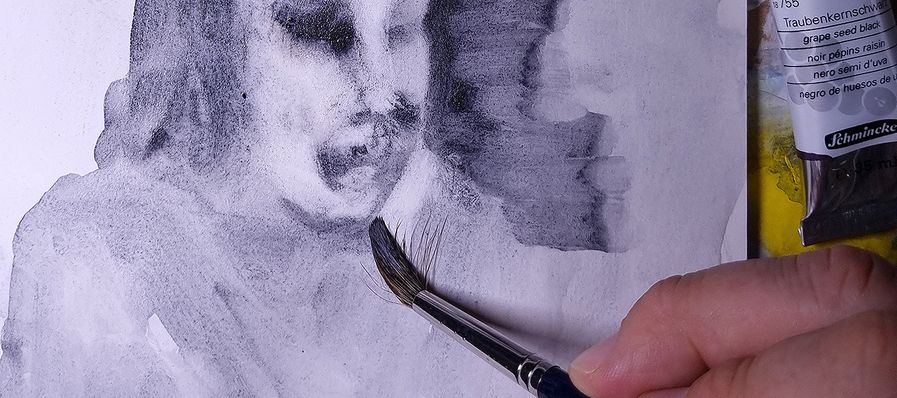
In the case of surface sizing, size is applied to the already dried paper surface. This creates a much more durable surface. You can lift paints more easily from surface-sized papers with a damp, clean cloth or brush. Surface sized paper is more resistant to repeated erasure, and adhesive tape is more easy to peel off without damaging the paper.
Unsized or very lightly sized papers are used in printmaking, so they absorb colour rapidly to avoid smudging.
Surface texture
Paper surface is has a strong influence on the look of an artwork. There are three main categories: Rough (self-evident); Cold Press, also called Matte or NOT (as in not rough), which has visible tooth but not to the degree of Rough; and Smooth or Hot Press (pressed with hot rollers as the paper emerges still wet from the machine), which has very little discernible tooth. These surfaces will vary between various paper types, and with the different felts used.
Each surface reacts differently to your media. Rough papers tend to add an illusion of depth to painting, as varied thicknesses of pigment lay thinly on the raised part and deeper in the trough of the surface. They’re especially favoured by landscape painters. Smooth papers produce flat, delicate areas of paint and allow for fine detail and line work. They are often chosen for portraiture, botanical work, lithography, and screenprinting. Cold Press papers are most popular, as they fall somewhere in between these extremes and so are suitable for many applications and techniques.

GSM
The weight of the paper is expressed in Grams per Square Metre (GSM). This often coincides with the thickness, but a loosely formed paper may feel thicker than a highly calendared paper of the same weight. Usually, a thick paper of 250 - 300gsm is more appropriate for painting, as it does not distort as it absorbs moisture as much as a thinner paper. 600gsm papers hardly move at all, even with very wet paint. Thinner papers are suited to dry media techniques and hand-rubbing when print making.
Acid-free and Archival
Non-archival paper degrades quickly when exposed to UV and moisture. Old newspapers grow brittle and yellow when left in the sun. As well as suiting your technique, a good art paper should resist the damaging effects of UV light and humidity. All Hahnemühle papers are acid-free, archival and highly resistant to ageing.
We have been bringing many exciting Hahnemühle papers direct into Aotearoa New Zealand since 1991. Every paper has its own characteristics, so let’s take a look at some of our favourites.
Hahnemühle Natural Line
Three fast growing, sustainable fibres are used by Hahnemühle in their eco-friendly Natural Line papers: bamboo, hemp, and agave. These are easily renewed resources that require less processing. All are blended with lesser proportions of cotton for strength, and each paper has unique surface qualities due to their composition.
Natural Line Hemp Sketch
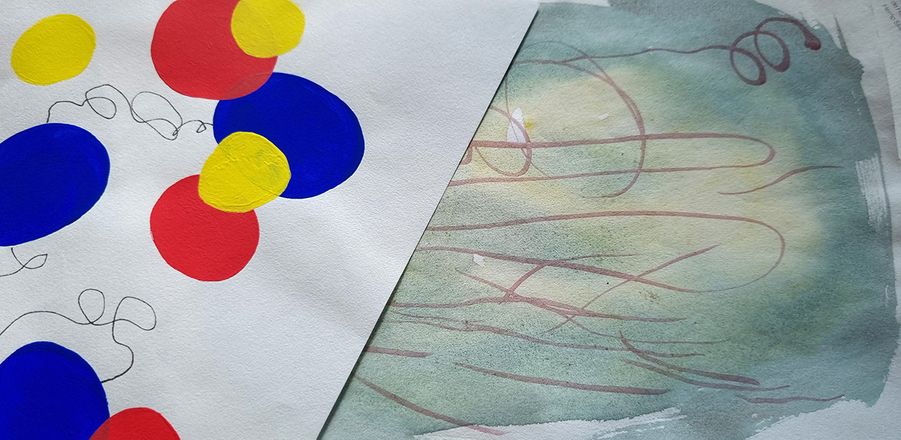
Made from 60% hemp fibre with 40% cotton, 80gsm Hemp Sketch is a very durable paper for dry media and pen & ink. Hemp Sketch handles plenty of work with an eraser without “pilling” the surface, and ink lines remain crisp and defined. Despite its light weight, the tough surface and fine grain also make this a very attractive paper for rough sketching in watercolour, gouache, and acrylic. Hemp Sketch is acid-free and archival.
Natural Line Agave Watercolour
Agave paper can be used with any water-based paint, and the unique surface is especially responsive to granulating colours.
From 70% agave fibre with 30% cotton, 290gsm Agave Watercolour has a unique surface effect for watercolour painting, especially for glazing. The special surface has a smooth feel under the brush, while its unusual grain becomes apparent when colour is applied, as the absorbency favours a textural appearance of the watercolour. This is especially visible with granulating colours, which are highly emphasised.
The surface sizing offers the ability to lift colours and use masking fluid, tape and erasing without damaging the surface.
Natural Line Bamboo Mixed Media
The particular absorbency and surface texture of Bamboo lends it to most techniques, from dry media and ink to painting and printmaking.
Due to its unique surface, this natural-white 265gsm artist paper is very well suited for different drawing and painting techniques, as well as mixed media techniques. The colour flows beautifully, with high contrasts and excellent colour intensity can be achieved with every technique. Bamboo is particularly well suited for watercolour, acrylic and pastel-painting techniques, as well as sketching, and even printmaking.
The Collection Watercolour Paper
All class: the Collection Watercolour block is protected by a tracing paper dust cover, and the break in the black edging indicates where to slice the sheet from the block once your painting is complete. In contrast to a pad, a block has all four sides glued to ensures maximum stability while working. Any movement in the paper due to water will flatten out when left “blocked” to dry, then the finished painting can be sliced off with a palette knife to reveal a fresh sheet underneath.
The Collection sets new standards for high-quality watercolour papers. A carefully chosen blend of cotton offers extremely strong fibres and incomparable purity, and the special surface sizing provides a very durable surface particularly suited for demanding watercolour techniques. The fibres do not lift, rub off or loosen, even when applying multiple layers of colour, or when using masking fluids and tapes. The colours remain brilliant, and the surface offers excellent control, especially for wet-on-wet paintings.
The Collection Watercolour Paper is available in 300gsm and 640gsm weights, and in Hot Press, Cold Press, and Rough surfaces.
Harmony
Harmony offers students a high performance paper for watercolour painting in three surfaces, all surface sized to give you brighter colours, easy lifting of colour, and extra durable for erasing, masking fluids and tapes.
In order to offer a high performing watercolour paper at a very affordable price, Hahnemühle developed the Harmony range of 300gsm papers in Hot Press, Cold Press, and Rough surfaces, with a special addition. Usually reserved for cotton papers, they decided to make Harmony surface sized, allowing for very specific control of watercolour.
Wet colours can be easily corrected or taken off, and colour stands out excellently on the paper. Masking fluids and masking tapes can be used and removed residue-free, and the surface is very eraser resistant.
Harmony’s very reasonable price makes it ideal for students of watercolour, offering a much more nuanced surface than papers of a comparable price, while being noticeably more affordable than pure rag papers.
Hahnemühle 1584
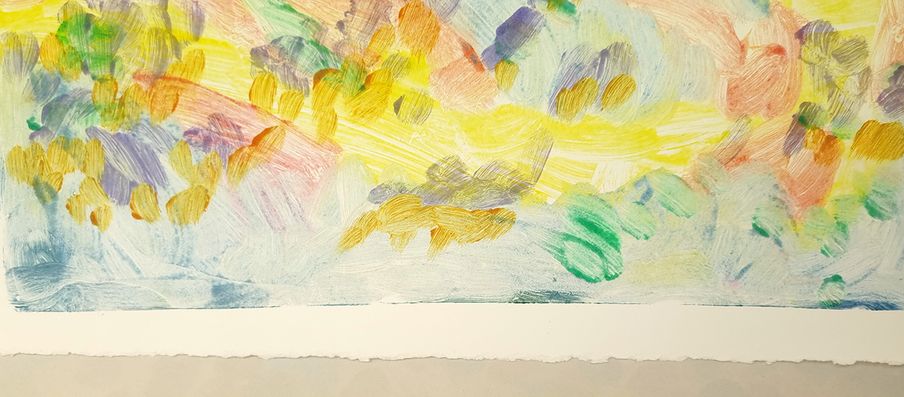
Named for the year the paper mill began, this paper symbolises the company’s tradition to produce the perfect artist paper. A premium printmaking paper, 1584 is made of pure cotton and is unsized, making it extremely absorbent. The 300gsm paper has a particularly satin-smooth surface, is firm and hard-wearing, while the cotton fibres provide flexibility at the same time. Four deckle edges and a watermark complete this high-quality paper.
Hahnemühle 1584 is particularly well suited for woodcut and silkscreen, offset and uncoated/treated digital printing processes. Even in the case of multi-layer applications, colours are absorbed extremely well.
The problem with paper
Paper is the most versatile, cost-effective surface for drawing, painting, and printmaking. You can buy a couple of 140gsm A1 sheet of D&S Drawing Paper for less than the price of a coffee; you can paint a few coats of gesso onto a sheet of 300gsm Britannia for an excellent oilpainting support. If you want to paint big, we have giant sheets as well as rolls; if you want small, cut it down. Artwork didn’t work out? Just turn the sheet over and start again – two sides for the one price!
So what’s the problem with paper? It all looks very similar. We stock around 100 papers, each sheet with its own set of specific characteristics, and you won’t know how well it matches your requirements until you try it. Asking our staff or buying a single sheet is a good way to experiment; or for the more expensive papers, you can try the Hahnemühle Watercolour Selection Pad.
The Watercolour Selection Pad contains a wide selection of high-quality Hahnemühle papers with a variety of surfaces and grammages. From exquisite 100% cotton papers to examples of resource-saving natural fibres and papers made from pure alpha-cellulose, your new favourite paper is bound to be in there!
https://www.gordonharris.co.nz/product/30330-hahnemuhle-watercolour-selection-pad-17-x-24cm


